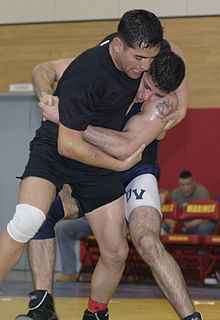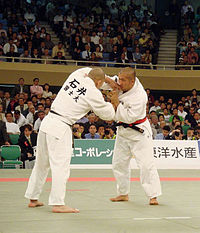Clinch fighting
This article needs additional citations for verification. (March 2024) |

Clinch fighting or trapping is the part of
Clinch fighting is emphasized in both
In combat sports
Clinch fighting is the primary focus of many

Grappling techniques
The clinch is a powerful tool for grapplers to advance into a
In competition where such clothing is being worn (almost exclusively referred to as a gi) there is a strong emphasis on grip fighting where the fighters will attempt to gain a dominant hold on the opponent's gi to unbalance and throw them. Examples of such competition would be judo, sambo or some Brazilian Jiu Jitsu competitions although in BJJ there is frequently a division for both gi and no-gi competition.
In no-gi competition getting double underhooks is generally considered advantageous, as the position can be used to perform throws or takedowns. Being behind the opponent in such a position is known as getting the back, and is generally considered even more advantageous, since it is harder for the opponent to defend from that position. A typical example of a technique that can be performed from this position is the suplex.
Hand and arm positions
While clinching, the position of a fighter's arms is vitally important. The fighter always tries to keep his arms on the inside of his opponent's, allowing him to press his elbows together building a tighter grip. The fighter attempts to always hold his hands in a "cupping" position.[1]
Striking techniques
A multitude of striking techniques exist that can be used effectively from the clinch.
Submission techniques
There are very few
See also
References
- Danaher, John. Fighting in the Clinch: A Key Skill in Real Fighting. www.realfighting.com. URL last accessed January 7, 2006.
- Gracie, Renzo; Danaher, John. Two Approaches to Fighting in the Clinch*. www.humankinetics.com. URL last accessed January 7, 2006.
- Pedreira, Roberto. The Subtle Science of the Muay Thai Clinch. URL last accessed December 16, 2006.
- ^ Bradshaw, B. "Clinch Fighting: A How to Guide for Muay Thai". Muaythai.com. Muay Thai. Retrieved 23 March 2024.
